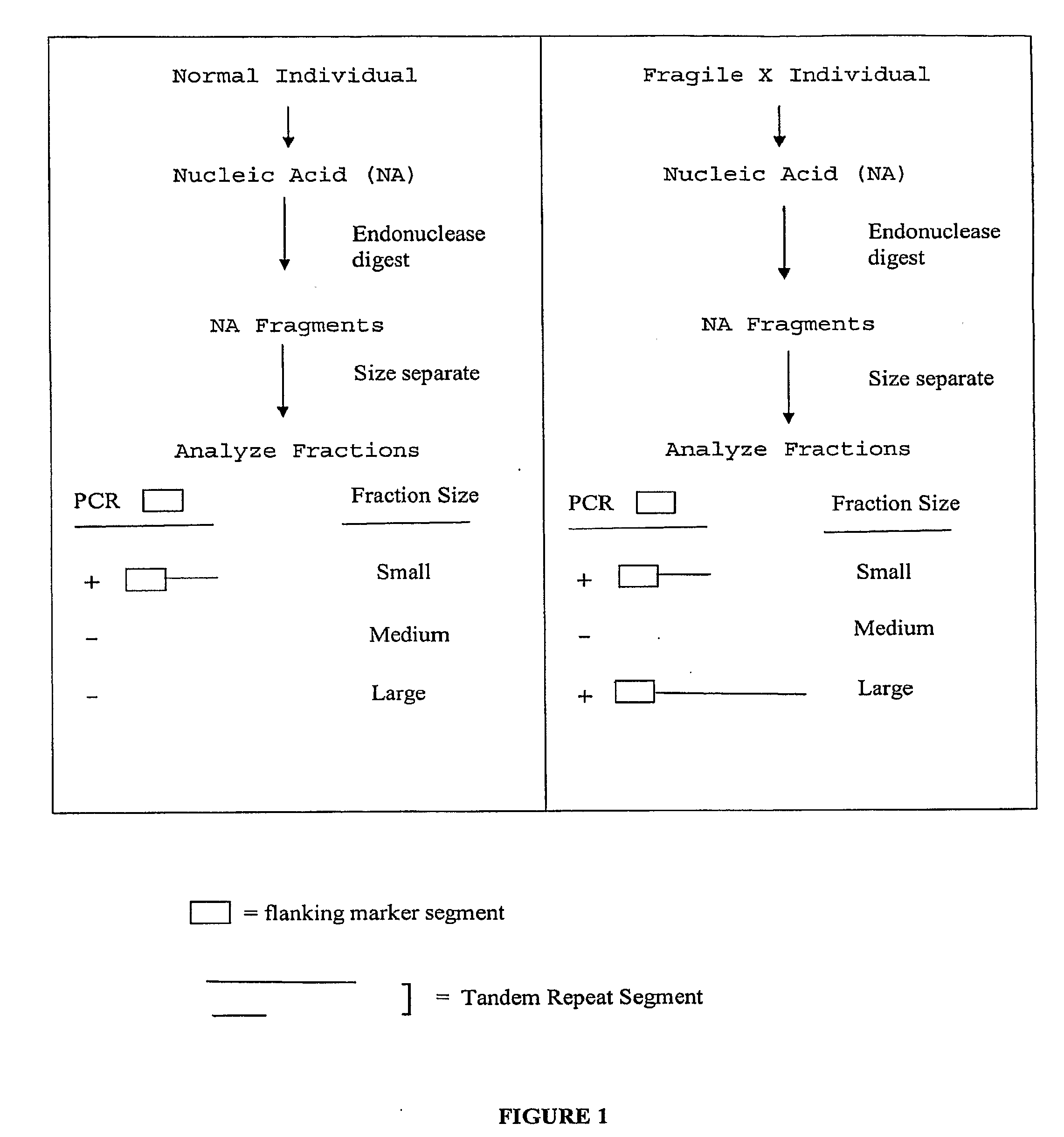Nucleic acid size detection method
a nucleic acid and size detection technology, applied in the field of medical diagnostics, can solve the problems of higher risk of expansion to a full mutation in any offspring, and affect the risk of offspring, and achieve the effect of finer estimation of the number of tandem repeats
- Summary
- Abstract
- Description
- Claims
- Application Information
AI Technical Summary
Benefits of technology
Problems solved by technology
Method used
Image
Examples
example 1
[0227]This example describes methods to detect expansion of the tandem repeat region of the FMR1 gene. Genomic DNA test samples and control samples of DNA were restriction endonuclease digested with AluI. 1.0 μg of test or control DNA was used for each digest. Genomic DNA was purified and diluted to a concentration of 50 ng / μL. The reaction mix for the digest was prepared according to the following table.
TABLE 5AluI reaction mixReagent(μL / sample)10X NEBuffer 23.0AluI (10 U / μL)1.0Sterile H2O7.0Total10.0
[0228]10 μL of the AluI reaction mix was added to each sample of DNA. The samples were mixed by vortexing and spinning in a microfuge and are then incubated overnight at 37° C.
example 2
Size Separation of Digested DNA
[0229]A. Two Fraction Approach
[0230]Restriction enzyme digested DNA as described in Example 1 was separated into fractions according to size. 1 kb DNA ladder and the digested test genomic DNA samples were placed into a 96-well plate. The plate was subjected to auto-sampling and automatic fractionation using a Beckman Coulter P / ACE MDQ Series Capillary Electrophoresis System in reversed polarity separation mode. The ladder was first injected into the capillary with 6 kv / 60 sec, then run with 200 V / cm to determine the correct sizing cutoff time. Automated fraction collection was accomplished using a preset fractionation time window corresponding to 211-400 bp (lower fraction) and 401 bp-9 kb (upper fraction). The separations are monitored on-column by UV detection. The data were acquired and evaluated by the P / ACE MDQ 32 Karat software package.
[0231]The digested samples were fractionated using the same conditions as the 1 kb DNA ladder. The lower fractio...
example 3
PCR Amplification and Detection of Fragments with Tandem Repeats
[0236]In an assay to detect mutations characterized by an expansion of the tandem repeat region of the FMR1 gene, working PCR master mixes were made as described.
[0237]A. PCR Amplification (Non-Taqman)
[0238]A PCR Master Mix for amplifying fragments and for size separation analysis of PCR product was prepared as shown in Table 6.
TABLE 6Preparation of PCR primer (non-Taqman) master mix for CCG5′ flanking sequenceOne Reaction500 ReactionsFinalStock Solution(μL)(μL)Concentration10X PCR Buffer (with2.512501X (1.5 mM)15 mM MgCl2)5X Q-Solution5.0025001X25 mM MgCl20.52500.5mM25 mM dNTPs0.21000.2mM100 μM FMR1F40.52502.0μMPrimer(SEQ ID NO: 4)100 μM FMR1R40.52502.0μMPrimer(SEQ ID NO: 5)100 μM AluIF Primer0.1500.4μM(SEQ ID NO: 10)100 μM AluIR Primer0.1500.4μM(SEQ ID NO: 11)100 μM LargeF Primer0.10500.4μM(SEQ ID NO: 14)100 μM LargeR0.102500.4μMPrimer(SEQ ID NO: 15)DMSO1.256255%1M KCl21.2562550mMdH2O7.53750Total19.69800
[0239]The PCR ...
PUM
| Property | Measurement | Unit |
|---|---|---|
| total volume | aaaaa | aaaaa |
| total volume | aaaaa | aaaaa |
| concentration | aaaaa | aaaaa |
Abstract
Description
Claims
Application Information
 Login to View More
Login to View More - R&D
- Intellectual Property
- Life Sciences
- Materials
- Tech Scout
- Unparalleled Data Quality
- Higher Quality Content
- 60% Fewer Hallucinations
Browse by: Latest US Patents, China's latest patents, Technical Efficacy Thesaurus, Application Domain, Technology Topic, Popular Technical Reports.
© 2025 PatSnap. All rights reserved.Legal|Privacy policy|Modern Slavery Act Transparency Statement|Sitemap|About US| Contact US: help@patsnap.com



